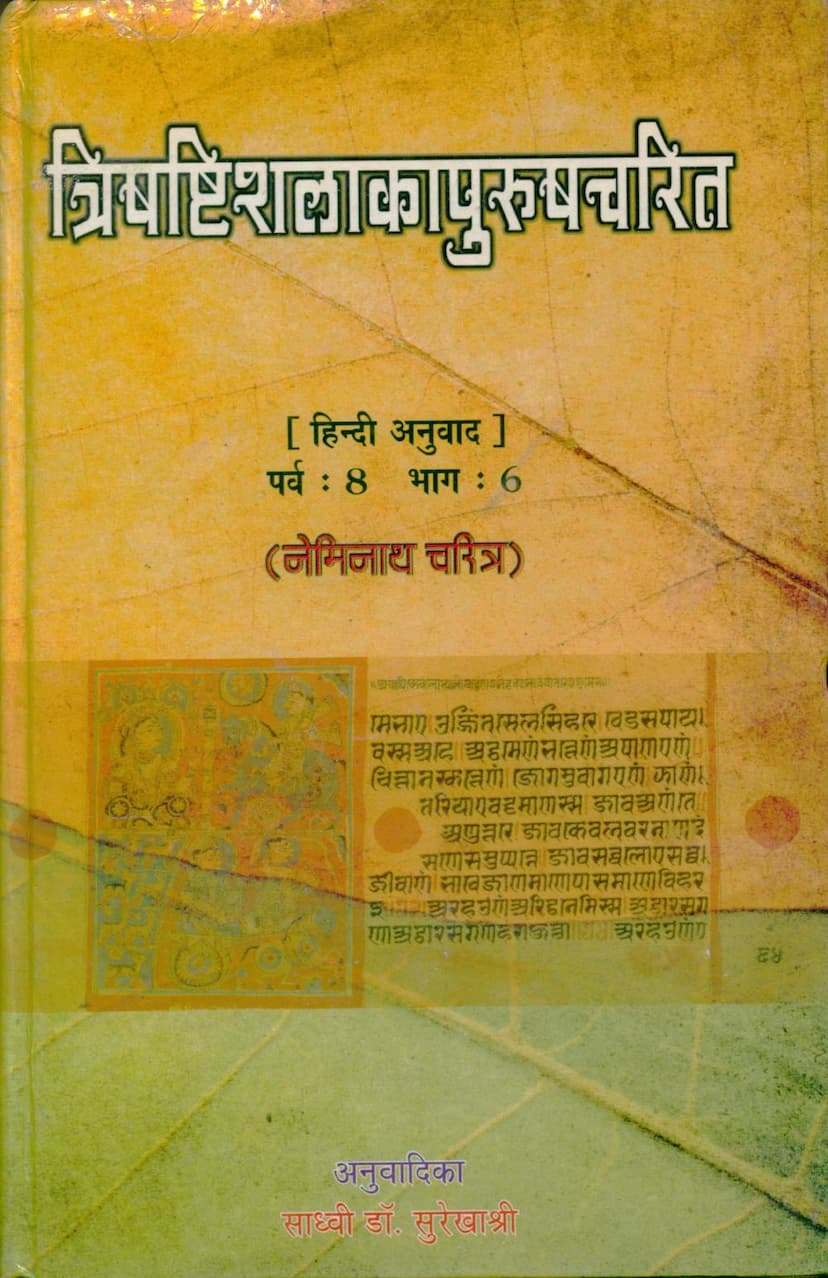Trishashti Shalaka Purush Charit Part 06
Added to library: September 2, 2025

Summary
Here's a comprehensive summary of the provided Jain text, "Trishashti Shalaka Purush Charit Part 06" (Paryaya 8, Part 6 - Nemnath Charitra), translated and compiled by Sadhvi Dr. Surekha Shri:
This book, published by Prakrit Bharti Academy, Jaipur, is the Hindi translation of the eighth chapter of Acharya Hemachandra's monumental work, "Trishashti Shalaka Purush Charit." This specific volume (Part 06) focuses on the lives of significant figures within the Jain tradition, including Tirthankar Neminath, Vasudeva Krishna, Baldev Balbhadra, and Prativasudeva Jarashanda.
Introduction to the Trishashti Shalaka Purush Charit:
The text begins by explaining the concept of the "Trishashti Shalaka Purush," which refers to the 63 supreme beings who appear in each epoch of the Jain cosmology (both ascending and descending eras). These 63 individuals are categorized as:
- 24 Tirthankaras
- 12 Chakravartis (Universal Emperors)
- 6 Vasudevas (Divine Heroes)
- 9 Prativasudevas (Anti-heroes)
- 9 Baladevas (Strong Heroes)
Acharya Hemachandra meticulously documented the lives of these 63 Mahapurushas in his original Sanskrit work, divided into 10 chapters. This Hindi translation aims to make these invaluable life stories accessible to a wider audience, offering insights into historical events and moral values.
Summary of the Contents (Chapter 8 - Neminath Charitra):
This particular volume (Part 6 of Chapter 8) covers the following key narratives:
-
Previous Lives of Shri Arishtanemi (Neminath): The first chapter details the celestial and human rebirths of Neminath, emphasizing his virtuous deeds and the gradual path towards enlightenment. The story of Dhanakumar, who is destined to become the 22nd Tirthankara in a future life, is narrated. Dhanakumar's life, his marriage to Dhanavati, and the profound impact of a painted portrait on her are described, highlighting the power of divine attraction and destiny. The chapter also touches upon the concept of transmigration and the karmic influences shaping future lives.
-
The Life of Vasudeva Krishna and the Yadava Dynasty: The second chapter delves into the lineage and prominent figures of the Yadava dynasty, focusing on the early life and upbringing of Vasudeva Krishna. It traces the ancestry from King Vasu to Krishna's father, Vasudev, and the complex relationships within the family. The narrative introduces the eventual antagonist, Kamsa, and the establishment of Dwarka city. The text also includes the story of Kanakavati and her marriage, as well as the Nal-Damayanti tale, illustrating the intricate tapestry of lives intertwined by destiny and karma.
-
The Story of Vidhyadhar and Vasudeva: This section likely elaborates on the supernatural powers and exploits of the Vidhyadhara race, often interacting with and influencing the lives of human heroes like Vasudeva. It includes the birth of Krishna and Balrama, the downfall of Kamsa, and the establishment of the flourishing city of Dwarka. The narrative also touches upon the marriages of Rukmini and other women, the Swayamvara of Draupadi, and the character of Pradyumna, Krishna's son. The text further narrates the marriages of Shamb and Pradyumna, and the eventual defeat of Jarashanda, a significant Prativasudeva. The philosophical underpinnings of these events, such as the concepts of karma and rebirth, are implicitly conveyed through the unfolding of these lives.
-
Further Narratives: The volume also includes the episode of Sagarachandra, the story of Ushaharan, the slaying of Banasura, the divine pastimes and eventual renunciation and attainment of omniscience by Arishtanemi (Neminath), and the tragic events surrounding Draupadi's abduction, the character of Gajasukumala, the destruction of Dwarka, and the final moments of Krishna and the departure of Baladeva to heaven.
Overall Themes and Significance:
This part of the Trishashti Shalaka Purush Charit, focusing on Neminath and the lineage of Vasudeva Krishna, serves to illustrate several key Jain principles:
- Karma and Rebirth: The lives of these individuals are presented as a testament to the law of karma. The consequences of their actions, both virtuous and otherwise, shape their destinies across multiple lifetimes.
- Destiny and Free Will: While destiny plays a significant role, the choices and efforts of these great souls in pursuing righteousness and overcoming obstacles are also highlighted.
- Moral Values and Right Conduct: The narratives are rich with moral lessons, emphasizing virtues like compassion, righteousness, loyalty, and the pursuit of liberation.
- The Interconnectedness of Lives: The stories often reveal how the lives of different individuals are intertwined, with past actions influencing present circumstances and future rebirths.
- The Path to Liberation: Ultimately, the lives of the Tirthankaras like Neminath serve as a beacon, demonstrating the possibility of achieving ultimate freedom from the cycle of birth and death through spiritual discipline and detachment.
The translation by Sadhvi Dr. Surekha Shri is lauded for its simplicity, accuracy, and effectiveness in conveying the profound messages of these ancient Jain scriptures. The book aims to inspire readers to contemplate these human values and strive for personal growth and spiritual upliftment.